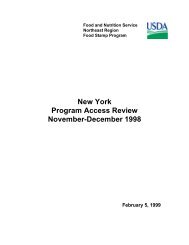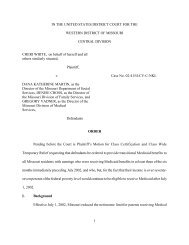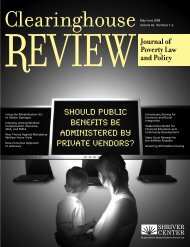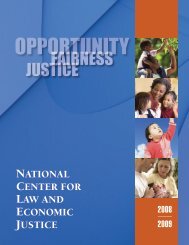The Role of the Courts in Securing Welfare Rights and ...
The Role of the Courts in Securing Welfare Rights and ...
The Role of the Courts in Securing Welfare Rights and ...
Create successful ePaper yourself
Turn your PDF publications into a flip-book with our unique Google optimized e-Paper software.
<strong>Welfare</strong> Law Center<strong>the</strong> named pla<strong>in</strong>tiffs, but later ruled aga<strong>in</strong>st pla<strong>in</strong>tiffs on <strong>the</strong> ground that <strong>the</strong> policy does notviolate equal protection. <strong>The</strong> court did not address <strong>the</strong> Article XVII claim. An appeal is pend<strong>in</strong>g.<strong>The</strong> existence <strong>of</strong> <strong>the</strong> constitutional provision was a significant factor <strong>in</strong> <strong>the</strong> New YorkState legislature’s 1997 enactment <strong>of</strong> welfare reform provisions which do not term<strong>in</strong>ate aid at <strong>the</strong>end <strong>of</strong> <strong>the</strong> relevant time limit, but <strong>in</strong>stead provide primarily voucher payments. Whe<strong>the</strong>r this issufficient is an open question. This is a good example <strong>of</strong> how constitutional norms can play animportant role <strong>in</strong> <strong>in</strong>fluenc<strong>in</strong>g state legislative decisions.In Montana a state equal protection challenge to a limited program for able-bodied<strong>in</strong>dividuals without children succeeded based on state constitutional language requir<strong>in</strong>g <strong>the</strong>legislature to provide for <strong>the</strong> needy. However, voters subsequently amended <strong>the</strong> constitution toremove <strong>the</strong> provision on which <strong>the</strong> court had relied. 105Unfavorable decisions <strong>in</strong>clude Moore v. Ganim, 106 which rejected by a 4-3 vote achallenge to a Connecticut law which allowed localities to limit GA to “employables” to 9 out <strong>of</strong>12 months; Bullock v. Whitman, 107 an unsuccessful challenge to Kansas restrictions <strong>in</strong> GeneralAssistance eligibility, <strong>in</strong> which <strong>the</strong> court none<strong>the</strong>less acknowledged <strong>the</strong> possibility that at somepo<strong>in</strong>t restrictions could violate <strong>the</strong> constitution; <strong>and</strong> Daugherty v. Wallace, 108 which rejected aclaim that a six-month time limit on GA for those not qualify<strong>in</strong>g for Disability Assistanceviolated <strong>the</strong> state constitution.Second, state traditions may support claims <strong>of</strong> a duty to provide assistance. <strong>The</strong>se<strong>in</strong>clude <strong>the</strong> follow<strong>in</strong>g:State tradition <strong>of</strong> car<strong>in</strong>g for <strong>the</strong> poor. An extensive argument based on longst<strong>and</strong><strong>in</strong>gstate traditions <strong>of</strong> assist<strong>in</strong>g <strong>the</strong> poor was made <strong>and</strong> rejected <strong>in</strong> Moore v. Ganim.Special protection for children embodied <strong>in</strong> <strong>the</strong> parens patraie doctr<strong>in</strong>e. Thisdoctr<strong>in</strong>e refers to <strong>the</strong> state’s authority to protect those unable to protect <strong>the</strong>mselves. This is anuntested <strong>the</strong>ory as a basis for a constitutional duty.Third, state courts have fewer constra<strong>in</strong>ts than federal courts <strong>in</strong> address<strong>in</strong>g social policyissues. Ramsey <strong>and</strong> Braveman suggest that state courts are more comfortable deal<strong>in</strong>g with publicMay 1999⋅ 40 ⋅








